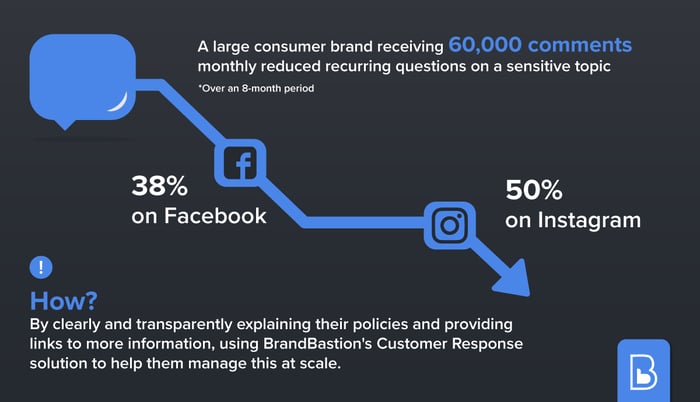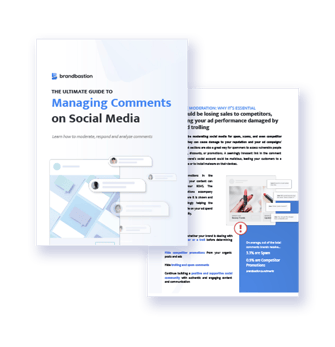
Why and How Should Brands Respond to Customers on Social Media?
Responding to customers on social media can be a terrifying thought for even the most seasoned marketers. One misstep can easily get amplified. At the same time, brands can drive positive brand perception by turning this risk into an opportunity.
When a brand exceeds expectations, many customers (45 percent) post and share about their positive experiences. This is completely unprecedented in marketing history. Before the advent of social media, how many people would take time out of their day to tell a brand that they are doing a great job?
To be that brand that exceeds expectations requires a strong social media response strategy. Previously, marketing and customer service teams operated in silos. With social media, there is greater overlap than ever before between these two functions. It requires cooperation and coordination between these functions to deliver both excellent brand experiences and customer service through social media channels.
At BrandBastion, we work with top brands to help them manage and respond to comments on ads and organic posts. We also help them deal with customer service-specific inquiries. We believe that brands should always reply on social media, regardless of the comment type.
But there are situations where responding publicly on social media is sufficient, and there are situations where the conversation should be moved to private channels.
When should you respond publicly and when should you push the conversation to a private channel?
1. Respond publicly to build trust and strengthen positive brand perception
Marketing strategist and renowned author Jay Baer writes that social media is a “spectator sport.” It is so important not only to respond, but to respond publicly. What can brands gain by responding publicly?
-
Demonstrate accountability and trustworthiness: According to a 2017 study by SproutSocial, 81 percent of consumers say that social media has increased accountability for businesses. The world is watching to see how brands respond each time a customer poses a question or complaint on social media. The interaction is no longer just between the brand and the customer, but also between everyone else the ad is visible to.
Even if a mistake is made by the brand or a customer is being unreasonable, brands who respond with tact and empathy are demonstrating to everyone watching that they can be trusted. (The top reason people call brands out on social media is for “Dishonesty”).
-
Gain valuable word-of-mouth marketing: When brands respond well, even to negative complaints, 45 percent of consumers will post about that positive experience on social media. This boosts confidence in your brand, as a single positive review from a customer outweighs all the positive things a brand can say about itself.
-
Shift public perception and explain company policies transparently: The comments section can quickly take on a life of its own if not managed carefully. For instance, many industries tend to receive high volumes of comments with the same recurring sensitive themes. Or, a scandal or an ad campaign perceived as tone-deaf can also result in social media backlash. For the beauty industry, animal testing is a recurring theme. For telecommunications, billing and price discrepancies are recurring topics. For transportation and delivery apps, sensitive customer information and order details shared in comments tends to be a common theme.
Such comments are usually negative in nature, and 1) create a negative perception of the brand for other viewers of the ad and 2) detract from the content that the ad is focusing on, be it a new product or a promotional offer. To protect your brand and ad spend, it can be valuable to take charge of the discussion. We have a blog post on the topic of more common mistakes when working with ads.

For instance, a large consumer brand we work with (receiving, on average, over 60,000 comments per month) has managed to reduce the volume of recurring questions on a sensitive topic significantly (50 percent on Instagram and 38 percent on Facebook) over an eight-month period. They did this simply by clearly and transparently explaining their policies and providing links to their website for more information. Over time, the number of such comments and the negativity and criticism related to this decreased across the brand’s properties.
-
Leverage negative situations to build positive perception: The study also found that reading even a single negative comment about a brand can significantly affect consumers’ perception of the brand. About 59 percent of people said they’d think twice about buying from that brand again.
However, there is a way brands can redeem such situations. A fraction of people surveyed said that such comments don’t impact their perception of the brand, either because they think the consumer is just a complainer or they don’t fully trust comments on social. While not responding to comments can make your brand look apathetic (triggering a 43 percent decrease in customer advocacy), responding actively, with empathy and professionalism, can turn negative situations around and build positive perception of your brand among all who are watching (boosting customer advocacy by 20 percent).
2. Move the conversation to the private domain to address personal issues and protect customers
While it is important to respond publicly, it is also important to ensure that additional follow-up happens as needed. Not all of these follow-up conversations need to continue publicly. We have an article dedicated to the topic, but here is a summarized version:
Research shows that to resolve complaints adequately, 60% of businesses have to go beyond one contact when it comes to responding on social media. There are some instances in which it might be more useful to move the conversation to the private domain, be it email, call - or even more conveniently for the customer - Facebook Messenger. These include:
- When your response needs to be in-depth: Your response may be constrained by a character limit. Continuing the conversation on another platform allows you to go as in-depth as needed with the customer without worrying about the limitations of responding via comments n social media.
- When sensitive customer information needs to be obtained: To protect the privacy of your customers and to avoid violating any policies (be it of the platform or of your company) related to data protection, there are times when the conversation absolutely must be moved to a private channel. You may need to obtain an e-mail address, order number, or phone number and such information cannot be shared publicly on social media.
-
When fast customer service needs to be provided: Sometimes, an urgent customer query needs to be handled within minutes, instead of days. Opening a support ticket and pushing the customer from a social channel handled by a marketing team to a channel where they can interact with a live customer service agent may be the best thing to do.
The benefit of having customer service agents helping customers out via Facebook Messenger is that the whole experience stays within the same platform for the customer. Once a customer has left a comment on a post made by the brand, the customer is considered to have opted to communicate and can be sent follow-up private messages via Messenger.
Want to learn more about how we can help in responding to customers at scale, quickly and effectively? Download our free guide: